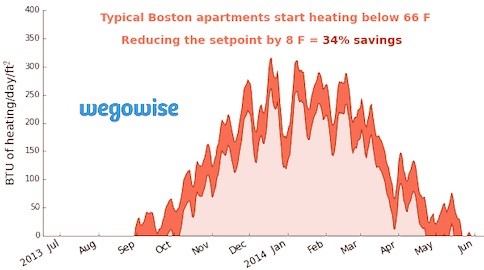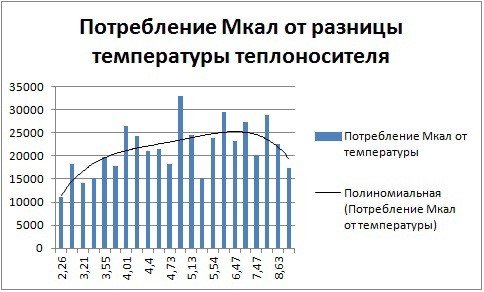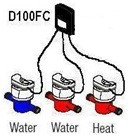 Why spend money on the equipment for housing heat metering? It’s worth the money!
Why spend money on the equipment for housing heat metering? It’s worth the money!
Studies conducted in the UK, in Russia, as well as the certificate of TERMOKOM, show that residents who installed equipment for apartment heat metering reduce heating bills by an average of 40-50%.
Moreover, this happens while maintaining a comfortable temperature because of the regime of rational heat consumption. For example during the day when you leave the house, the temperature can be lowered, at night a lower temperature is also recommended. The maintenance of windows and doors in good repair not only in the apartment, but also in the entrances, also contributes to the reduction of heat consumption.
When the consumer pays the heat actually consumed, he has an incentive in his rational expenditure. There is a desire to insulate the walls with polystyrene, replace the window frames with double-glazed windows, and keep the room temperature with mechanical or automatic controls, without removing excess heat through doors and windows.

The socially vulnerable layers of the population have the opportunity to save and do not accumulate huge debts to stay without heat in the apartment, and then possibly without an apartment. So reducing the temperature in the apartment only by 1°C – reduces the heat consumption from 6% to 12%. The diagram shows statistics for the city of Boston (USA), where a decrease in temperature of 4’C (8F) allowed saving about 34% on heating bills.
Also, the problem of cold batteries or uneven temperature distribution over the height of the riser is solved because of excessive uncontrolled consumption of heat by the apartments of the lower floors (in the basement layout) or by the apartments of the upper floors (when routing the technical floor). When housing heat metering and excessive consumption, excessive heating bills will come, which will force residents to adjust their heat consumption, and thus equalize the temperature at the height of the riser. When designing engineering heating systems, it is rational energy consumption that is laid, not uncontrolled consumption.
What a technique has come to!
If you have a horizontal distribution of the heating system, and the construction organization has saved heat meters, you as an association, can install them yourself. Convincing chairmen from Moldova, Azerbaijan, Russia and other CIS countries, for lack of sufficient finance (the most affordable heat meter costs about 100 euros, and its verification every 5 years for about 35 euros), install a standard counter for hot water instead of a heat meter. Having received the heat bill for the house, they divide the amount in proportion to the curved cubic meters of coolant for each apartment.
What are the benefits?
The consumer pays bills for the actual heat consumed.
If you consume a little, there is an opportunity to significantly reduce the payment for heat.
Who heals extra extensions or loggias, it will be honestly paid.
Optimal distribution of the risers will raise the temperature in the premises.
How can you control the consumption of heat?
To do this, use mechanical valves or automatic temperature controllers installed on the heating devices. Close the heaters with a dense cloth to reduce heat loss, if you have installed a conventional meter to account for the heat, you can not!
Is it possible to establish an accounting system only for individual tenants?
It is necessary to install the heat accounting system for the whole house – for the same methodology for calculating the heat consumed. It is possible to install both conventional meters and heat meters.
Calculate the difference in payment with conventional meters and heat meters.
For example, let’s take four consumers consuming the same amount of heat, but with different modes: from 60’C at the feed and 55’C at the return, up to 60’C at the feed and 20’C at the return, consuming 24 hours a day from 16 Cubes of coolant up to 2 cubes. The coefficient (k) takes into account the decrease in the heat transfer of the heating device when the temperature of the radiator falls. Having accepted the cost of 1 Mcal equal to 1 leu, we will calculate the amount to be paid for each consumer in the presence of a heat meter. It will be from 88 to 37.8 lei. In the case of a cubic meter calculation, we get from 144 lei to 18 lei. As you can see, a consumer with a large consumption, not setting himself the task of saving, will pay about 60% more than the standard payment for a heat meter, while the consumer with an average consumption approximately will pay the same amount as when paying for a heat meter.
 Consumers trying to save – usually those who are socially unprotected, will pay for about half of the heat they consume (see App.3 and App.4). This allows you to automatically observe the “social” consumption rate when you use the cumulative accounting method: the less you consume, the less you pay. The difference is paid by consumers who do not set themselves the task of saving.
Consumers trying to save – usually those who are socially unprotected, will pay for about half of the heat they consume (see App.3 and App.4). This allows you to automatically observe the “social” consumption rate when you use the cumulative accounting method: the less you consume, the less you pay. The difference is paid by consumers who do not set themselves the task of saving.
Six-year statistics on heat consumption for 206 apartment house on the street. Sulak 4 equipped with the accounting system BALANCE showed: the average temperature drop is 5.4 ‘C, i.е. The conversion coefficient from cubic meters of heat carrier to Mcal was 1 m3 = 5.4 Mcal.
From the diagram of the distribution of consumption from the temperature difference, it can be seen that about 30% of consumption fits in the 15% spread from the average temperature. Another 30% when switching to the account for m3 will save, they have a temperature difference greater than 6.2 °C and another 40% have a temperature difference of less than 4.6 ‘C, these tenants will pay extra to those who save.

The company DJV-COM offers to equip with heat meters apartments in multi-storey residential buildings. The installation of the accounting system BALANCE allows you to take into account the consumption of up to three water meters by one radio module. This means that your data on the consumption of cold water, hot water and heat, you can browse through the Internet, compare your water and heat consumption with the average for the house, assess whether you sparingly consume energy or you have an overuse, get a consumption forecast at the end of the month, And also receive warnings about leaks of cold and hot water.
The installation of a conventional meter to account for heat will cost about 300 to 400 lei, the installation of a radio module for three entrances is about 900 – 990 lei, and one concentrator will be required at the house.
About the heat accounting for vertical distribution of the heating system can be found in the article “Residential Heat Metering“.
For more information on heat, water, electricity and gas, please visit our website www.djv-com.org.


